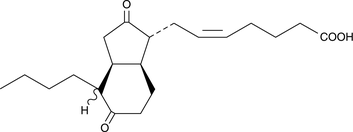Chemicals
Showing 11401–11550 of 41137 results
-
Bialaphos is a natural non-selective phytotoxin produced by certain Streptomyces species. It is a pro-toxin, a tripeptide that is converted in vivo to the active agent phosphinothricin, which is a glutamine analog.{27463} L-Phosphinothricin inhibits glutamine synthetase (Ki = 6.1 µM), resulting in accumulation of ammonium and disruption of primary metabolism.{27463,27464} The bacterial bar gene encodes a phosphinothricin acetyltransferase, which confers resistance to phosphinothricin.{27244} Bialaphos is used in the selection of transgenic plants that express the bar gene, usually under the control of a constitutively active viral promoter.{27244}
Brand:CaymanSKU:-Out of stock
Bialaphos is a natural non-selective phytotoxin produced by certain Streptomyces species. It is a pro-toxin, a tripeptide that is converted in vivo to the active agent phosphinothricin, which is a glutamine analog.{27463} L-Phosphinothricin inhibits glutamine synthetase (Ki = 6.1 µM), resulting in accumulation of ammonium and disruption of primary metabolism.{27463,27464} The bacterial bar gene encodes a phosphinothricin acetyltransferase, which confers resistance to phosphinothricin.{27244} Bialaphos is used in the selection of transgenic plants that express the bar gene, usually under the control of a constitutively active viral promoter.{27244}
Brand:CaymanSKU:-Out of stock
Biapenem is a broad-spectrum β-lactam antibiotic.{47703,47704} It is active against aerobic and anaerobic, Gram-positive and Gram-negative bacteria, including clinical isolates of E. coli, oxacillin-sensitive S. aureus, B. fragilis, and Clostridium (MIC90s = 0.12, 0.12, 0.25, and 1 μg/ml, respectively). It is also active against the rifampicin-susceptible H37Rv and rifampicin-resistant 115R and 124R M. tuberculosis strains (MICs = 2-4, 4-8, and 8-16 mg/L, respectively).{47705} Biapenem (200 mg/kg) decreases the number of lung colony-forming units (CFUs) in a mouse model of late-phase acute H37Rv M. tuberculosis infection.
Brand:CaymanSKU:28822 - 10 mgAvailable on backorder
Biapenem is a broad-spectrum β-lactam antibiotic.{47703,47704} It is active against aerobic and anaerobic, Gram-positive and Gram-negative bacteria, including clinical isolates of E. coli, oxacillin-sensitive S. aureus, B. fragilis, and Clostridium (MIC90s = 0.12, 0.12, 0.25, and 1 μg/ml, respectively). It is also active against the rifampicin-susceptible H37Rv and rifampicin-resistant 115R and 124R M. tuberculosis strains (MICs = 2-4, 4-8, and 8-16 mg/L, respectively).{47705} Biapenem (200 mg/kg) decreases the number of lung colony-forming units (CFUs) in a mouse model of late-phase acute H37Rv M. tuberculosis infection.
Brand:CaymanSKU:28822 - 100 mgAvailable on backorder
Biapenem is a broad-spectrum β-lactam antibiotic.{47703,47704} It is active against aerobic and anaerobic, Gram-positive and Gram-negative bacteria, including clinical isolates of E. coli, oxacillin-sensitive S. aureus, B. fragilis, and Clostridium (MIC90s = 0.12, 0.12, 0.25, and 1 μg/ml, respectively). It is also active against the rifampicin-susceptible H37Rv and rifampicin-resistant 115R and 124R M. tuberculosis strains (MICs = 2-4, 4-8, and 8-16 mg/L, respectively).{47705} Biapenem (200 mg/kg) decreases the number of lung colony-forming units (CFUs) in a mouse model of late-phase acute H37Rv M. tuberculosis infection.
Brand:CaymanSKU:28822 - 25 mgAvailable on backorder
Biapenem is a broad-spectrum β-lactam antibiotic.{47703,47704} It is active against aerobic and anaerobic, Gram-positive and Gram-negative bacteria, including clinical isolates of E. coli, oxacillin-sensitive S. aureus, B. fragilis, and Clostridium (MIC90s = 0.12, 0.12, 0.25, and 1 μg/ml, respectively). It is also active against the rifampicin-susceptible H37Rv and rifampicin-resistant 115R and 124R M. tuberculosis strains (MICs = 2-4, 4-8, and 8-16 mg/L, respectively).{47705} Biapenem (200 mg/kg) decreases the number of lung colony-forming units (CFUs) in a mouse model of late-phase acute H37Rv M. tuberculosis infection.
Brand:CaymanSKU:28822 - 50 mgAvailable on backorder
2,3-Oxidosqualene cyclase (OSC) is an important enzyme in the biosynthesis of animal, plant, and fungal sterols. OSC catalyzes the conversion of (3S)-2,3-oxidosqualene to lanosterol, a precursor to cholesterol, in mammals and fungi. BIBB 515 is a selective and potent inhibitor of OSC in vivo with an ED50 value of 0.2-0.5 and 0.36-33.3 mg/kg in rats and mice, respectively. Total cholesterol was reduced by 19% in normolipemic hamsters at a dose of 55 mg/kg/day for 11 days and 25% in hyperlipemic hamsters at a dose of 148 mg/kg/day for 25 days.{15844}
Brand:CaymanSKU:10010517 - 10 mgAvailable on backorder
2,3-Oxidosqualene cyclase (OSC) is an important enzyme in the biosynthesis of animal, plant, and fungal sterols. OSC catalyzes the conversion of (3S)-2,3-oxidosqualene to lanosterol, a precursor to cholesterol, in mammals and fungi. BIBB 515 is a selective and potent inhibitor of OSC in vivo with an ED50 value of 0.2-0.5 and 0.36-33.3 mg/kg in rats and mice, respectively. Total cholesterol was reduced by 19% in normolipemic hamsters at a dose of 55 mg/kg/day for 11 days and 25% in hyperlipemic hamsters at a dose of 148 mg/kg/day for 25 days.{15844}
Brand:CaymanSKU:10010517 - 100 mgAvailable on backorder
2,3-Oxidosqualene cyclase (OSC) is an important enzyme in the biosynthesis of animal, plant, and fungal sterols. OSC catalyzes the conversion of (3S)-2,3-oxidosqualene to lanosterol, a precursor to cholesterol, in mammals and fungi. BIBB 515 is a selective and potent inhibitor of OSC in vivo with an ED50 value of 0.2-0.5 and 0.36-33.3 mg/kg in rats and mice, respectively. Total cholesterol was reduced by 19% in normolipemic hamsters at a dose of 55 mg/kg/day for 11 days and 25% in hyperlipemic hamsters at a dose of 148 mg/kg/day for 25 days.{15844}
Brand:CaymanSKU:10010517 - 5 mgAvailable on backorder
2,3-Oxidosqualene cyclase (OSC) is an important enzyme in the biosynthesis of animal, plant, and fungal sterols. OSC catalyzes the conversion of (3S)-2,3-oxidosqualene to lanosterol, a precursor to cholesterol, in mammals and fungi. BIBB 515 is a selective and potent inhibitor of OSC in vivo with an ED50 value of 0.2-0.5 and 0.36-33.3 mg/kg in rats and mice, respectively. Total cholesterol was reduced by 19% in normolipemic hamsters at a dose of 55 mg/kg/day for 11 days and 25% in hyperlipemic hamsters at a dose of 148 mg/kg/day for 25 days.{15844}
Brand:CaymanSKU:10010517 - 50 mgAvailable on backorder
BIBF 1120 is an inhibitor of the receptor tyrosine kinases VEGFR, FGFR, and PDGFR (IC50s = 13-34, 37-610, 59, and 65 nM for VEGFR1-3, FGFR1-4, PDGFRα, and PDGFRβ, respectively).{20204} It is selective for VEGFR, FGFR, and PDGFR over a panel of 33 kinases but does inhibit FLT3, LCK, LYN, and Src (IC50s = 16-156 nM). BIBF 1120 inhibits growth factor-dependent proliferation of human umbilical vascular endothelial cells (HUVECs), human microvascular skin endothelial cells (HSMECs), human umbilical artery smooth muscle cells (HUASMCs), and bovine retinal pericytes (BRPs; EC50s = 7-290 nM). In vivo, BIBF 1120 (100 mg/kg) reduces tumor microvessel density and the number of PDGFRβ-expressing perivascular cells in a FaDu head and neck small cell carcinoma mouse xenograft model. It also inhibits tumor growth in a Caki-1 renal cancer mouse xenograft model. Formulations containing BIBF 1120 have been used in the treatment of idiopathic pulmonary fibrosis and non-small cell lung cancer (NSCLC).
Brand:CaymanSKU:11022 - 10 mgAvailable on backorder
BIBF 1120 is an inhibitor of the receptor tyrosine kinases VEGFR, FGFR, and PDGFR (IC50s = 13-34, 37-610, 59, and 65 nM for VEGFR1-3, FGFR1-4, PDGFRα, and PDGFRβ, respectively).{20204} It is selective for VEGFR, FGFR, and PDGFR over a panel of 33 kinases but does inhibit FLT3, LCK, LYN, and Src (IC50s = 16-156 nM). BIBF 1120 inhibits growth factor-dependent proliferation of human umbilical vascular endothelial cells (HUVECs), human microvascular skin endothelial cells (HSMECs), human umbilical artery smooth muscle cells (HUASMCs), and bovine retinal pericytes (BRPs; EC50s = 7-290 nM). In vivo, BIBF 1120 (100 mg/kg) reduces tumor microvessel density and the number of PDGFRβ-expressing perivascular cells in a FaDu head and neck small cell carcinoma mouse xenograft model. It also inhibits tumor growth in a Caki-1 renal cancer mouse xenograft model. Formulations containing BIBF 1120 have been used in the treatment of idiopathic pulmonary fibrosis and non-small cell lung cancer (NSCLC).
Brand:CaymanSKU:11022 - 100 mgAvailable on backorder
BIBF 1120 is an inhibitor of the receptor tyrosine kinases VEGFR, FGFR, and PDGFR (IC50s = 13-34, 37-610, 59, and 65 nM for VEGFR1-3, FGFR1-4, PDGFRα, and PDGFRβ, respectively).{20204} It is selective for VEGFR, FGFR, and PDGFR over a panel of 33 kinases but does inhibit FLT3, LCK, LYN, and Src (IC50s = 16-156 nM). BIBF 1120 inhibits growth factor-dependent proliferation of human umbilical vascular endothelial cells (HUVECs), human microvascular skin endothelial cells (HSMECs), human umbilical artery smooth muscle cells (HUASMCs), and bovine retinal pericytes (BRPs; EC50s = 7-290 nM). In vivo, BIBF 1120 (100 mg/kg) reduces tumor microvessel density and the number of PDGFRβ-expressing perivascular cells in a FaDu head and neck small cell carcinoma mouse xenograft model. It also inhibits tumor growth in a Caki-1 renal cancer mouse xenograft model. Formulations containing BIBF 1120 have been used in the treatment of idiopathic pulmonary fibrosis and non-small cell lung cancer (NSCLC).
Brand:CaymanSKU:11022 - 250 mgAvailable on backorder
BIBF 1120 is an inhibitor of the receptor tyrosine kinases VEGFR, FGFR, and PDGFR (IC50s = 13-34, 37-610, 59, and 65 nM for VEGFR1-3, FGFR1-4, PDGFRα, and PDGFRβ, respectively).{20204} It is selective for VEGFR, FGFR, and PDGFR over a panel of 33 kinases but does inhibit FLT3, LCK, LYN, and Src (IC50s = 16-156 nM). BIBF 1120 inhibits growth factor-dependent proliferation of human umbilical vascular endothelial cells (HUVECs), human microvascular skin endothelial cells (HSMECs), human umbilical artery smooth muscle cells (HUASMCs), and bovine retinal pericytes (BRPs; EC50s = 7-290 nM). In vivo, BIBF 1120 (100 mg/kg) reduces tumor microvessel density and the number of PDGFRβ-expressing perivascular cells in a FaDu head and neck small cell carcinoma mouse xenograft model. It also inhibits tumor growth in a Caki-1 renal cancer mouse xenograft model. Formulations containing BIBF 1120 have been used in the treatment of idiopathic pulmonary fibrosis and non-small cell lung cancer (NSCLC).
Brand:CaymanSKU:11022 - 50 mgAvailable on backorder
BIBF 1120 is an inhibitor of the receptor tyrosine kinases VEGFR, FGFR, and PDGFR (IC50s = 13-34, 37-610, 59, and 65 nM for VEGFR1-3, FGFR1-4, PDGFRα, and PDGFRβ, respectively).{20204} It is selective for VEGFR, FGFR, and PDGFR over a panel of 33 kinases but does inhibit FLT3, LCK, LYN, and Src (IC50s = 16-156 nM). BIBF 1120 inhibits growth factor-dependent proliferation of human umbilical vascular endothelial cells (HUVECs), human microvascular skin endothelial cells (HSMECs), human umbilical artery smooth muscle cells (HUASMCs), and bovine retinal pericytes (BRPs; EC50s = 7-290 nM). In vivo, BIBF 1120 (100 mg/kg) reduces tumor microvessel density and the number of PDGFRβ-expressing perivascular cells in a FaDu head and neck small cell carcinoma mouse xenograft model. It also inhibits tumor growth in a Caki-1 renal cancer mouse xenograft model. Formulations containing BIBF 1120 have been used in the treatment of idiopathic pulmonary fibrosis and non-small cell lung cancer (NSCLC).
Brand:CaymanSKU:31082 - 1 gAvailable on backorder
BIBF 1120 is an inhibitor of the receptor tyrosine kinases VEGFR, FGFR, and PDGFR (IC50s = 13-34, 37-610, 59, and 65 nM for VEGFR1-3, FGFR1-4, PDGFRα, and PDGFRβ, respectively).{20204} It is selective for VEGFR, FGFR, and PDGFR over a panel of 33 kinases but does inhibit FLT3, LCK, LYN, and Src (IC50s = 16-156 nM). BIBF 1120 inhibits growth factor-dependent proliferation of human umbilical vascular endothelial cells (HUVECs), human microvascular skin endothelial cells (HSMECs), human umbilical artery smooth muscle cells (HUASMCs), and bovine retinal pericytes (BRPs; EC50s = 7-290 nM). In vivo, BIBF 1120 (100 mg/kg) reduces tumor microvessel density and the number of PDGFRβ-expressing perivascular cells in a FaDu head and neck small cell carcinoma mouse xenograft model. It also inhibits tumor growth in a Caki-1 renal cancer mouse xenograft model. Formulations containing BIBF 1120 have been used in the treatment of idiopathic pulmonary fibrosis and non-small cell lung cancer (NSCLC).
Brand:CaymanSKU:31082 - 100 mgAvailable on backorder
BIBF 1120 is an inhibitor of the receptor tyrosine kinases VEGFR, FGFR, and PDGFR (IC50s = 13-34, 37-610, 59, and 65 nM for VEGFR1-3, FGFR1-4, PDGFRα, and PDGFRβ, respectively).{20204} It is selective for VEGFR, FGFR, and PDGFR over a panel of 33 kinases but does inhibit FLT3, LCK, LYN, and Src (IC50s = 16-156 nM). BIBF 1120 inhibits growth factor-dependent proliferation of human umbilical vascular endothelial cells (HUVECs), human microvascular skin endothelial cells (HSMECs), human umbilical artery smooth muscle cells (HUASMCs), and bovine retinal pericytes (BRPs; EC50s = 7-290 nM). In vivo, BIBF 1120 (100 mg/kg) reduces tumor microvessel density and the number of PDGFRβ-expressing perivascular cells in a FaDu head and neck small cell carcinoma mouse xenograft model. It also inhibits tumor growth in a Caki-1 renal cancer mouse xenograft model. Formulations containing BIBF 1120 have been used in the treatment of idiopathic pulmonary fibrosis and non-small cell lung cancer (NSCLC).
Brand:CaymanSKU:31082 - 50 mgAvailable on backorder
BIBF 1120 is an inhibitor of the receptor tyrosine kinases VEGFR, FGFR, and PDGFR (IC50s = 13-34, 37-610, 59, and 65 nM for VEGFR1-3, FGFR1-4, PDGFRα, and PDGFRβ, respectively).{20204} It is selective for VEGFR, FGFR, and PDGFR over a panel of 33 kinases but does inhibit FLT3, LCK, LYN, and Src (IC50s = 16-156 nM). BIBF 1120 inhibits growth factor-dependent proliferation of human umbilical vascular endothelial cells (HUVECs), human microvascular skin endothelial cells (HSMECs), human umbilical artery smooth muscle cells (HUASMCs), and bovine retinal pericytes (BRPs; EC50s = 7-290 nM). In vivo, BIBF 1120 (100 mg/kg) reduces tumor microvessel density and the number of PDGFRβ-expressing perivascular cells in a FaDu head and neck small cell carcinoma mouse xenograft model. It also inhibits tumor growth in a Caki-1 renal cancer mouse xenograft model. Formulations containing BIBF 1120 have been used in the treatment of idiopathic pulmonary fibrosis and non-small cell lung cancer (NSCLC).
Brand:CaymanSKU:31082 - 500 mgAvailable on backorder
BIBF 1202 is an active metabolite of the VEGFR, FGFR, and PDGFR inhibitor BIBF 1120 (nintedanib; Item No. 11022).{20204,47489} It is formed from BIBF 1120 by intracellular esterases.{20204} BIBF 1202 inhibits VEGFR2 with an IC50 value of 62 nM.
Brand:CaymanSKU:27176 - 1 mgAvailable on backorder
BIBF 1202 is an active metabolite of the VEGFR, FGFR, and PDGFR inhibitor BIBF 1120 (nintedanib; Item No. 11022).{20204,47489} It is formed from BIBF 1120 by intracellular esterases.{20204} BIBF 1202 inhibits VEGFR2 with an IC50 value of 62 nM.
Brand:CaymanSKU:27176 - 10 mgAvailable on backorder
BIBF 1202 is an active metabolite of the VEGFR, FGFR, and PDGFR inhibitor BIBF 1120 (nintedanib; Item No. 11022).{20204,47489} It is formed from BIBF 1120 by intracellular esterases.{20204} BIBF 1202 inhibits VEGFR2 with an IC50 value of 62 nM.
Brand:CaymanSKU:27176 - 5 mgAvailable on backorder
BIBR 1532 is a mixed-type non-competitive inhibitor of telomerase (IC50 = 93 nM) that has little effect on several mammalian DNA and RNA polymerases, bacterial DNA helicase, or HIV-1 reverse transcriptase.{27220,27216,27218} It specifically targets the telomerase reverse transcriptase catalytic subunit, TERT.{27216,27217} Through its effects on telomerase, BIBR 1532 induces senescence or apoptosis in cancer cells.{27220,27219} Apoptosis in triple negative breast cancer cells induced by BIBR 1532 is potentiated by glucose restriction.{27219}
Brand:CaymanSKU:-Out of stock
BIBR 1532 is a mixed-type non-competitive inhibitor of telomerase (IC50 = 93 nM) that has little effect on several mammalian DNA and RNA polymerases, bacterial DNA helicase, or HIV-1 reverse transcriptase.{27220,27216,27218} It specifically targets the telomerase reverse transcriptase catalytic subunit, TERT.{27216,27217} Through its effects on telomerase, BIBR 1532 induces senescence or apoptosis in cancer cells.{27220,27219} Apoptosis in triple negative breast cancer cells induced by BIBR 1532 is potentiated by glucose restriction.{27219}
Brand:CaymanSKU:-Out of stock
BIBR 1532 is a mixed-type non-competitive inhibitor of telomerase (IC50 = 93 nM) that has little effect on several mammalian DNA and RNA polymerases, bacterial DNA helicase, or HIV-1 reverse transcriptase.{27220,27216,27218} It specifically targets the telomerase reverse transcriptase catalytic subunit, TERT.{27216,27217} Through its effects on telomerase, BIBR 1532 induces senescence or apoptosis in cancer cells.{27220,27219} Apoptosis in triple negative breast cancer cells induced by BIBR 1532 is potentiated by glucose restriction.{27219}
Brand:CaymanSKU:-Out of stock
BIBR 1532 is a mixed-type non-competitive inhibitor of telomerase (IC50 = 93 nM) that has little effect on several mammalian DNA and RNA polymerases, bacterial DNA helicase, or HIV-1 reverse transcriptase.{27220,27216,27218} It specifically targets the telomerase reverse transcriptase catalytic subunit, TERT.{27216,27217} Through its effects on telomerase, BIBR 1532 induces senescence or apoptosis in cancer cells.{27220,27219} Apoptosis in triple negative breast cancer cells induced by BIBR 1532 is potentiated by glucose restriction.{27219}
Brand:CaymanSKU:-Out of stock
BIBS39 is a nonpeptide antagonist of the angiotensin II type 1 (AT1) receptor (Ki = 29 nM in rat lung membranes).{46447} It is selective for AT1 over AT2 receptors (Ki = 480 nM in isolated rat adrenal medulla), as well as α1-, α2-, β1-, and β2-adrenergic, adenosine A1 and A2, muscarinic M1, M2, and M3, and atrial natriuretic peptide receptors (Kis = >100 µM for all). BIBS39 (0.3-10 mg/kg) decreases diastolic blood pressure in pithed normotensive rats without affecting heart rate and in renal hypertensive rats with an increase in heart rate when administered at doses ranging from 1 to 30 mg/kg.{46447,46448}
Brand:CaymanSKU:22932 - 1 mgAvailable on backorder
BIBS39 is a nonpeptide antagonist of the angiotensin II type 1 (AT1) receptor (Ki = 29 nM in rat lung membranes).{46447} It is selective for AT1 over AT2 receptors (Ki = 480 nM in isolated rat adrenal medulla), as well as α1-, α2-, β1-, and β2-adrenergic, adenosine A1 and A2, muscarinic M1, M2, and M3, and atrial natriuretic peptide receptors (Kis = >100 µM for all). BIBS39 (0.3-10 mg/kg) decreases diastolic blood pressure in pithed normotensive rats without affecting heart rate and in renal hypertensive rats with an increase in heart rate when administered at doses ranging from 1 to 30 mg/kg.{46447,46448}
Brand:CaymanSKU:22932 - 10 mgAvailable on backorder
BIBS39 is a nonpeptide antagonist of the angiotensin II type 1 (AT1) receptor (Ki = 29 nM in rat lung membranes).{46447} It is selective for AT1 over AT2 receptors (Ki = 480 nM in isolated rat adrenal medulla), as well as α1-, α2-, β1-, and β2-adrenergic, adenosine A1 and A2, muscarinic M1, M2, and M3, and atrial natriuretic peptide receptors (Kis = >100 µM for all). BIBS39 (0.3-10 mg/kg) decreases diastolic blood pressure in pithed normotensive rats without affecting heart rate and in renal hypertensive rats with an increase in heart rate when administered at doses ranging from 1 to 30 mg/kg.{46447,46448}
Brand:CaymanSKU:22932 - 25 mgAvailable on backorder
BIBS39 is a nonpeptide antagonist of the angiotensin II type 1 (AT1) receptor (Ki = 29 nM in rat lung membranes).{46447} It is selective for AT1 over AT2 receptors (Ki = 480 nM in isolated rat adrenal medulla), as well as α1-, α2-, β1-, and β2-adrenergic, adenosine A1 and A2, muscarinic M1, M2, and M3, and atrial natriuretic peptide receptors (Kis = >100 µM for all). BIBS39 (0.3-10 mg/kg) decreases diastolic blood pressure in pithed normotensive rats without affecting heart rate and in renal hypertensive rats with an increase in heart rate when administered at doses ranging from 1 to 30 mg/kg.{46447,46448}
Brand:CaymanSKU:22932 - 5 mgAvailable on backorder
BIBX1382 is an EGFR inhibitor (IC50 = 3 nM).{52264} It is selective for EGFR over HER2 (IC50 = 3,400 nM), as well as insulin-like growth factor 1 receptor (IGF-1R), β-insulin receptor kinase (β-InsRK), c-Met, c-Src, and VEGFR2 (IC50s = >10 µM for all). BIBX1382 inhibits proliferation and colony formation in A549 cancer cells expressing mutant K-Ras, as well as FaDu cancer cells expressing wild-type K-Ras when used at a concentration of 5 µM.{52265} It enhances radiation-induced cytotoxicity in mutant K-Ras-expressing A549 and MDA-MB-231 cancer cells, but not FaDu, HTB-35, or HH4dd cancer cells that express wild-type K-Ras. BIBX1382 reduces tumor growth in A431 and FaDu mouse xenograft models when administered at doses of 70 and 60 mg/kg per day, respectively.{52264}
Brand:CaymanSKU:29630 - 1 mgAvailable on backorder
BIBX1382 is an EGFR inhibitor (IC50 = 3 nM).{52264} It is selective for EGFR over HER2 (IC50 = 3,400 nM), as well as insulin-like growth factor 1 receptor (IGF-1R), β-insulin receptor kinase (β-InsRK), c-Met, c-Src, and VEGFR2 (IC50s = >10 µM for all). BIBX1382 inhibits proliferation and colony formation in A549 cancer cells expressing mutant K-Ras, as well as FaDu cancer cells expressing wild-type K-Ras when used at a concentration of 5 µM.{52265} It enhances radiation-induced cytotoxicity in mutant K-Ras-expressing A549 and MDA-MB-231 cancer cells, but not FaDu, HTB-35, or HH4dd cancer cells that express wild-type K-Ras. BIBX1382 reduces tumor growth in A431 and FaDu mouse xenograft models when administered at doses of 70 and 60 mg/kg per day, respectively.{52264}
Brand:CaymanSKU:29630 - 10 mgAvailable on backorder
BIBX1382 is an EGFR inhibitor (IC50 = 3 nM).{52264} It is selective for EGFR over HER2 (IC50 = 3,400 nM), as well as insulin-like growth factor 1 receptor (IGF-1R), β-insulin receptor kinase (β-InsRK), c-Met, c-Src, and VEGFR2 (IC50s = >10 µM for all). BIBX1382 inhibits proliferation and colony formation in A549 cancer cells expressing mutant K-Ras, as well as FaDu cancer cells expressing wild-type K-Ras when used at a concentration of 5 µM.{52265} It enhances radiation-induced cytotoxicity in mutant K-Ras-expressing A549 and MDA-MB-231 cancer cells, but not FaDu, HTB-35, or HH4dd cancer cells that express wild-type K-Ras. BIBX1382 reduces tumor growth in A431 and FaDu mouse xenograft models when administered at doses of 70 and 60 mg/kg per day, respectively.{52264}
Brand:CaymanSKU:29630 - 25 mgAvailable on backorder
BIBX1382 is an EGFR inhibitor (IC50 = 3 nM).{52264} It is selective for EGFR over HER2 (IC50 = 3,400 nM), as well as insulin-like growth factor 1 receptor (IGF-1R), β-insulin receptor kinase (β-InsRK), c-Met, c-Src, and VEGFR2 (IC50s = >10 µM for all). BIBX1382 inhibits proliferation and colony formation in A549 cancer cells expressing mutant K-Ras, as well as FaDu cancer cells expressing wild-type K-Ras when used at a concentration of 5 µM.{52265} It enhances radiation-induced cytotoxicity in mutant K-Ras-expressing A549 and MDA-MB-231 cancer cells, but not FaDu, HTB-35, or HH4dd cancer cells that express wild-type K-Ras. BIBX1382 reduces tumor growth in A431 and FaDu mouse xenograft models when administered at doses of 70 and 60 mg/kg per day, respectively.{52264}
Brand:CaymanSKU:29630 - 5 mgAvailable on backorder
Bicalutamide is a non-steroidal androgen receptor antagonist that binds the androgen receptor (Ki = 12.5 μM; IC50 = 1.2 μM), preventing its activation and subsequent upregulation of androgen responsive genes by androgenic hormones.{22431,22433} Bicalutamide is frequently used to examine the role of androgen receptor inactivation in the proliferation of prostate cancer cells and has served as a molecular template for the design and structural optimization of more selective androgen receptor modulators for androgen therapy.{22432,22430}
Brand:CaymanSKU:-Bicalutamide is a non-steroidal androgen receptor antagonist that binds the androgen receptor (Ki = 12.5 μM; IC50 = 1.2 μM), preventing its activation and subsequent upregulation of androgen responsive genes by androgenic hormones.{22431,22433} Bicalutamide is frequently used to examine the role of androgen receptor inactivation in the proliferation of prostate cancer cells and has served as a molecular template for the design and structural optimization of more selective androgen receptor modulators for androgen therapy.{22432,22430}
Brand:CaymanSKU:-Bicalutamide is a non-steroidal androgen receptor antagonist that binds the androgen receptor (Ki = 12.5 μM; IC50 = 1.2 μM), preventing its activation and subsequent upregulation of androgen responsive genes by androgenic hormones.{22431,22433} Bicalutamide is frequently used to examine the role of androgen receptor inactivation in the proliferation of prostate cancer cells and has served as a molecular template for the design and structural optimization of more selective androgen receptor modulators for androgen therapy.{22432,22430}
Brand:CaymanSKU:-Bicalutamide is a non-steroidal androgen receptor antagonist that binds the androgen receptor (Ki = 12.5 μM; IC50 = 1.2 μM), preventing its activation and subsequent upregulation of androgen responsive genes by androgenic hormones.{22431,22433} Bicalutamide is frequently used to examine the role of androgen receptor inactivation in the proliferation of prostate cancer cells and has served as a molecular template for the design and structural optimization of more selective androgen receptor modulators for androgen therapy.{22432,22430}
Brand:CaymanSKU:-Bicalutamide is a non-steroidal androgen receptor antagonist that binds the androgen receptor (Ki = 12.5 μM; IC50 = 1.2 μM), preventing its activation and subsequent upregulation of androgen responsive genes by androgenic hormones.{22431,22433} Bicalutamide is frequently used to examine the role of androgen receptor inactivation in the proliferation of prostate cancer cells and has served as a molecular template for the design and structural optimization of more selective androgen receptor modulators for androgen therapy.{22432,22430}
Brand:CaymanSKU:-Bicalutamide-d4 is intended for use as an internal standard for the quantification of bicalutamide (Item No. 14250) by GC- or LC-MS. Bicalutamide is a non-steroidal androgen receptor antagonist that binds the androgen receptor (Ki = 12.5 μM; IC50 = 1.2 μM), preventing its activation and subsequent upregulation of androgen responsive genes by androgenic hormones.{22431,22433} Bicalutamide is frequently used to examine the role of androgen receptor inactivation in the proliferation of prostate cancer cells and has served as a molecular template for the design and structural optimization of more selective androgen receptor modulators for androgen therapy.{22432,22430}
Brand:CaymanSKU:22377 -Out of stock
Bicalutamide-d4 is intended for use as an internal standard for the quantification of bicalutamide (Item No. 14250) by GC- or LC-MS. Bicalutamide is a non-steroidal androgen receptor antagonist that binds the androgen receptor (Ki = 12.5 μM; IC50 = 1.2 μM), preventing its activation and subsequent upregulation of androgen responsive genes by androgenic hormones.{22431,22433} Bicalutamide is frequently used to examine the role of androgen receptor inactivation in the proliferation of prostate cancer cells and has served as a molecular template for the design and structural optimization of more selective androgen receptor modulators for androgen therapy.{22432,22430}
Brand:CaymanSKU:22377 -Out of stock
Bictegravir is an inhibitor of HIV-1 integrase (IC50 = 7.5 nM for strand transfer activity).{47145} It has antiviral activity against clinical isolates of HIV-1 in human peripheral blood mononuclear cells (PBMCs; EC50s = 0.04-1.7 nM). Bictegravir also inhibits HIV-1 viral infection in MT-2 and MT-4 cells, CD4+ T cells, and macrophages (EC50s = 1.5, 2.5, 1.5, and 6.6 nM, respectively) without exhibiting cytotoxicity (CC50s = 10.3, 3.7, 13, and 29.8 μM, respectively).
Brand:CaymanSKU:26532 - 1 mgAvailable on backorder
Bictegravir is an inhibitor of HIV-1 integrase (IC50 = 7.5 nM for strand transfer activity).{47145} It has antiviral activity against clinical isolates of HIV-1 in human peripheral blood mononuclear cells (PBMCs; EC50s = 0.04-1.7 nM). Bictegravir also inhibits HIV-1 viral infection in MT-2 and MT-4 cells, CD4+ T cells, and macrophages (EC50s = 1.5, 2.5, 1.5, and 6.6 nM, respectively) without exhibiting cytotoxicity (CC50s = 10.3, 3.7, 13, and 29.8 μM, respectively).
Brand:CaymanSKU:26532 - 10 mgAvailable on backorder
Bictegravir is an inhibitor of HIV-1 integrase (IC50 = 7.5 nM for strand transfer activity).{47145} It has antiviral activity against clinical isolates of HIV-1 in human peripheral blood mononuclear cells (PBMCs; EC50s = 0.04-1.7 nM). Bictegravir also inhibits HIV-1 viral infection in MT-2 and MT-4 cells, CD4+ T cells, and macrophages (EC50s = 1.5, 2.5, 1.5, and 6.6 nM, respectively) without exhibiting cytotoxicity (CC50s = 10.3, 3.7, 13, and 29.8 μM, respectively).
Brand:CaymanSKU:26532 - 25 mgAvailable on backorder
Bictegravir is an inhibitor of HIV-1 integrase (IC50 = 7.5 nM for strand transfer activity).{47145} It has antiviral activity against clinical isolates of HIV-1 in human peripheral blood mononuclear cells (PBMCs; EC50s = 0.04-1.7 nM). Bictegravir also inhibits HIV-1 viral infection in MT-2 and MT-4 cells, CD4+ T cells, and macrophages (EC50s = 1.5, 2.5, 1.5, and 6.6 nM, respectively) without exhibiting cytotoxicity (CC50s = 10.3, 3.7, 13, and 29.8 μM, respectively).
Brand:CaymanSKU:26532 - 5 mgAvailable on backorder
Ionotropic GABAA receptors are ligand-gated ion channels that facilitate the passing of chloride ions across the cell membrane and promote an inhibitory influence on target neurons. These receptors are the major targets for benzodiazepines and related anxiolytic drugs.{18157} Bicuculline is a competitive GABAA receptor antagonist that can act as an allosteric inhibitor at GABAA receptors.{21007,21009} At 100 μM, it blocks spontaneously opening chloride channels in the outside-out patches from the cultured cortical neurons.{21009} Bicuculline also reversibly blocks GABAA receptors on horizontal cells in the mouse retina with an IC50 value of 1.7 μM.{21010} By blocking the inhibitory action of GABA, bicuculline mimics the action of epilepsy and is widely used in experimental studies as a convulsant, inducing seizure in hippocampal or cortical neurons in prepared brain slices.{21008}
Brand:CaymanSKU:11727 - 100 mgAvailable on backorder
Ionotropic GABAA receptors are ligand-gated ion channels that facilitate the passing of chloride ions across the cell membrane and promote an inhibitory influence on target neurons. These receptors are the major targets for benzodiazepines and related anxiolytic drugs.{18157} Bicuculline is a competitive GABAA receptor antagonist that can act as an allosteric inhibitor at GABAA receptors.{21007,21009} At 100 μM, it blocks spontaneously opening chloride channels in the outside-out patches from the cultured cortical neurons.{21009} Bicuculline also reversibly blocks GABAA receptors on horizontal cells in the mouse retina with an IC50 value of 1.7 μM.{21010} By blocking the inhibitory action of GABA, bicuculline mimics the action of epilepsy and is widely used in experimental studies as a convulsant, inducing seizure in hippocampal or cortical neurons in prepared brain slices.{21008}
Brand:CaymanSKU:11727 - 50 mgAvailable on backorder
Ionotropic GABAA receptors are ligand-gated ion channels that facilitate the passing of chloride ions across the cell membrane and promote an inhibitory influence on target neurons. These receptors are the major targets for benzodiazepines and related anxiolytic drugs.{18157} Bicuculline is a competitive GABAA receptor antagonist that can act as an allosteric inhibitor at GABAA receptors.{21007,21009} At 100 μM, it blocks spontaneously opening chloride channels in the outside-out patches from the cultured cortical neurons.{21009} Bicuculline also reversibly blocks GABAA receptors on horizontal cells in the mouse retina with an IC50 value of 1.7 μM.{21010} By blocking the inhibitory action of GABA, bicuculline mimics the action of epilepsy and is widely used in experimental studies as a convulsant, inducing seizure in hippocampal or cortical neurons in prepared brain slices.{21008}
Brand:CaymanSKU:11727 - 500 mgAvailable on backorder
Bicyclo prostaglandin E2 (bicyclo PGE2) is a stable breakdown product of PGE2 (Item No. 14010) and 13,14-dihydro-15-keto PGE2 (Item No. 14650). Bicyclo PGE2 is a stable, base-catalyzed transformation product of 13,14-dihydro-15-keto PGE2. 13,14-dihydro-15-keto PGE2 itself is a metabolite of PGE2 found in human plasma at a median level of 20-25 pg/ml.{182,4383} Due to the inherent instability of 13,14-dihydro-15-keto PGE2, it is advisable to quantify it as bicyclo PGE2 to estimate PGE2 biosynthesis or metabolism in vivo.{2571,581}
Brand:CaymanSKU:-Bicyclo prostaglandin E2 (bicyclo PGE2) is a stable breakdown product of PGE2 (Item No. 14010) and 13,14-dihydro-15-keto PGE2 (Item No. 14650). Bicyclo PGE2 is a stable, base-catalyzed transformation product of 13,14-dihydro-15-keto PGE2. 13,14-dihydro-15-keto PGE2 itself is a metabolite of PGE2 found in human plasma at a median level of 20-25 pg/ml.{182,4383} Due to the inherent instability of 13,14-dihydro-15-keto PGE2, it is advisable to quantify it as bicyclo PGE2 to estimate PGE2 biosynthesis or metabolism in vivo.{2571,581}
Brand:CaymanSKU:-Bicyclo prostaglandin E2 (bicyclo PGE2) is a stable breakdown product of PGE2 (Item No. 14010) and 13,14-dihydro-15-keto PGE2 (Item No. 14650). Bicyclo PGE2 is a stable, base-catalyzed transformation product of 13,14-dihydro-15-keto PGE2. 13,14-dihydro-15-keto PGE2 itself is a metabolite of PGE2 found in human plasma at a median level of 20-25 pg/ml.{182,4383} Due to the inherent instability of 13,14-dihydro-15-keto PGE2, it is advisable to quantify it as bicyclo PGE2 to estimate PGE2 biosynthesis or metabolism in vivo.{2571,581}
Brand:CaymanSKU:-Bicyclol is a hepatoprotective agent.{37151,37152,37153,37154} It has antiviral activity against hepatitis B (HBV), reducing viral DNA and the secretion of the HBV antigens HBsAg and HBeAg by 59 and 35%, respectively, in infected 2.2.15 HepG2 cells.{37151} In vivo, bicyclol reduces duck HBV (DHBV) DNA in DHBV-infected ducks at doses ≥0.4 g/kg. It also reduces the expression of TNF-α and the accumulation of lymphocytes in the liver in a mouse model of liver injury induced by concanavalin A (Item No. 14951).{37152} Oral administration of bicyclol prior to injection of diethylnitrosamine (DEN) and phenobarbital (PB; Item Nos. 9001494 | 20987) prevents formation of DEN/PB-induced hepatocellular carcinomas.{37153} It also reduces liver fibrosis in a rat model of bile duct ligation-induced hepatic fibrosis.{37154}
Brand:CaymanSKU:21551 -Out of stock
Bicyclol is a hepatoprotective agent.{37151,37152,37153,37154} It has antiviral activity against hepatitis B (HBV), reducing viral DNA and the secretion of the HBV antigens HBsAg and HBeAg by 59 and 35%, respectively, in infected 2.2.15 HepG2 cells.{37151} In vivo, bicyclol reduces duck HBV (DHBV) DNA in DHBV-infected ducks at doses ≥0.4 g/kg. It also reduces the expression of TNF-α and the accumulation of lymphocytes in the liver in a mouse model of liver injury induced by concanavalin A (Item No. 14951).{37152} Oral administration of bicyclol prior to injection of diethylnitrosamine (DEN) and phenobarbital (PB; Item Nos. 9001494 | 20987) prevents formation of DEN/PB-induced hepatocellular carcinomas.{37153} It also reduces liver fibrosis in a rat model of bile duct ligation-induced hepatic fibrosis.{37154}
Brand:CaymanSKU:21551 -Out of stock
Bicyclol is a hepatoprotective agent.{37151,37152,37153,37154} It has antiviral activity against hepatitis B (HBV), reducing viral DNA and the secretion of the HBV antigens HBsAg and HBeAg by 59 and 35%, respectively, in infected 2.2.15 HepG2 cells.{37151} In vivo, bicyclol reduces duck HBV (DHBV) DNA in DHBV-infected ducks at doses ≥0.4 g/kg. It also reduces the expression of TNF-α and the accumulation of lymphocytes in the liver in a mouse model of liver injury induced by concanavalin A (Item No. 14951).{37152} Oral administration of bicyclol prior to injection of diethylnitrosamine (DEN) and phenobarbital (PB; Item Nos. 9001494 | 20987) prevents formation of DEN/PB-induced hepatocellular carcinomas.{37153} It also reduces liver fibrosis in a rat model of bile duct ligation-induced hepatic fibrosis.{37154}
Brand:CaymanSKU:21551 -Out of stock
Bicyclomycin benzoate is an antibiotic produced by S. sapporonensis that inhibits Gram-negative bacteria, including E. coli, Klebsiella, Shigella, Salmonella, Citrobacter, E. cloacae, and the pathogenic group of Neisseria.{24917,24916} It is inactive against Proteus, P. aeruginosa, and Gram-positive bacteria.{24917,24916}
Brand:CaymanSKU:-Bicyclomycin benzoate is an antibiotic produced by S. sapporonensis that inhibits Gram-negative bacteria, including E. coli, Klebsiella, Shigella, Salmonella, Citrobacter, E. cloacae, and the pathogenic group of Neisseria.{24917,24916} It is inactive against Proteus, P. aeruginosa, and Gram-positive bacteria.{24917,24916}
Brand:CaymanSKU:-Bifenazate is a carbazate acaricide that provides 100% control of mites when used at a concentration of 25 ppm.{36331} It acts as a positive allosteric modulator of GABA receptors containing the resistance to dieldrin (Rdl) subunit homolog TuGABAR in T. urticae (spider mites), shifting the GABA-induced response from an EC50 value of 24.8 to 4.83 µM when used at a concentration of 30 µM.{36330} Formulations containing bifenazate have been used for the control of mites and for pesticide detection.
Brand:CaymanSKU:24147 - 100 mgAvailable on backorder
Bifenazate is a carbazate acaricide that provides 100% control of mites when used at a concentration of 25 ppm.{36331} It acts as a positive allosteric modulator of GABA receptors containing the resistance to dieldrin (Rdl) subunit homolog TuGABAR in T. urticae (spider mites), shifting the GABA-induced response from an EC50 value of 24.8 to 4.83 µM when used at a concentration of 30 µM.{36330} Formulations containing bifenazate have been used for the control of mites and for pesticide detection.
Brand:CaymanSKU:24147 - 25 mgAvailable on backorder
Bifenazate is a carbazate acaricide that provides 100% control of mites when used at a concentration of 25 ppm.{36331} It acts as a positive allosteric modulator of GABA receptors containing the resistance to dieldrin (Rdl) subunit homolog TuGABAR in T. urticae (spider mites), shifting the GABA-induced response from an EC50 value of 24.8 to 4.83 µM when used at a concentration of 30 µM.{36330} Formulations containing bifenazate have been used for the control of mites and for pesticide detection.
Brand:CaymanSKU:24147 - 50 mgAvailable on backorder
Bifenthrin is a synthetic pyrethroid insecticide that prolongs opening of sodium channels resulting in membrane depolarization and conductance block in the insect nervous system.{36375} It is effective against A. gambiae and C. quinquefasciatus mosquitos (LD50s = 0.15 and 0.16 ng/mg, respectively) and increases O. insidiosus mortality in treated corn and sorghum plants.{41760,41761} Bifenthrin exhibits aquatic toxicity, inducing reproductive defects and lethality in D. magna (LC50 = 12.4 µg/L).{41762} Acute oral administration of bifenthrin induces fine tremor, decreases motor activity and grip strength, and increases pawing and head shaking behaviors in rats, indicating typical Type I pyrethroid neurotoxicity.{41763} Bifenthrin (8 mg/kg) also decreases locomotor activity, induces anemia, elevates white blood cell counts, alanine transaminase (ALT), and superoxide dismutase (SOD), as well as decreases glutathione peroxidase (Gpx) activity in mice.{41764}
Brand:CaymanSKU:24057 - 10 mgAvailable on backorder
Bifenthrin is a synthetic pyrethroid insecticide that prolongs opening of sodium channels resulting in membrane depolarization and conductance block in the insect nervous system.{36375} It is effective against A. gambiae and C. quinquefasciatus mosquitos (LD50s = 0.15 and 0.16 ng/mg, respectively) and increases O. insidiosus mortality in treated corn and sorghum plants.{41760,41761} Bifenthrin exhibits aquatic toxicity, inducing reproductive defects and lethality in D. magna (LC50 = 12.4 µg/L).{41762} Acute oral administration of bifenthrin induces fine tremor, decreases motor activity and grip strength, and increases pawing and head shaking behaviors in rats, indicating typical Type I pyrethroid neurotoxicity.{41763} Bifenthrin (8 mg/kg) also decreases locomotor activity, induces anemia, elevates white blood cell counts, alanine transaminase (ALT), and superoxide dismutase (SOD), as well as decreases glutathione peroxidase (Gpx) activity in mice.{41764}
Brand:CaymanSKU:24057 - 25 mgAvailable on backorder
Bifenthrin is a synthetic pyrethroid insecticide that prolongs opening of sodium channels resulting in membrane depolarization and conductance block in the insect nervous system.{36375} It is effective against A. gambiae and C. quinquefasciatus mosquitos (LD50s = 0.15 and 0.16 ng/mg, respectively) and increases O. insidiosus mortality in treated corn and sorghum plants.{41760,41761} Bifenthrin exhibits aquatic toxicity, inducing reproductive defects and lethality in D. magna (LC50 = 12.4 µg/L).{41762} Acute oral administration of bifenthrin induces fine tremor, decreases motor activity and grip strength, and increases pawing and head shaking behaviors in rats, indicating typical Type I pyrethroid neurotoxicity.{41763} Bifenthrin (8 mg/kg) also decreases locomotor activity, induces anemia, elevates white blood cell counts, alanine transaminase (ALT), and superoxide dismutase (SOD), as well as decreases glutathione peroxidase (Gpx) activity in mice.{41764}
Brand:CaymanSKU:24057 - 5 mgAvailable on backorder
Bifenthrin is a synthetic pyrethroid insecticide that prolongs opening of sodium channels resulting in membrane depolarization and conductance block in the insect nervous system.{36375} It is effective against A. gambiae and C. quinquefasciatus mosquitos (LD50s = 0.15 and 0.16 ng/mg, respectively) and increases O. insidiosus mortality in treated corn and sorghum plants.{41760,41761} Bifenthrin exhibits aquatic toxicity, inducing reproductive defects and lethality in D. magna (LC50 = 12.4 µg/L).{41762} Acute oral administration of bifenthrin induces fine tremor, decreases motor activity and grip strength, and increases pawing and head shaking behaviors in rats, indicating typical Type I pyrethroid neurotoxicity.{41763} Bifenthrin (8 mg/kg) also decreases locomotor activity, induces anemia, elevates white blood cell counts, alanine transaminase (ALT), and superoxide dismutase (SOD), as well as decreases glutathione peroxidase (Gpx) activity in mice.{41764}
Brand:CaymanSKU:24057 - 50 mgAvailable on backorder
Bifeprunox is an atypical antipsychotic.{52217} It is a dopamine D2 receptor partial agonist and an agonist of the serotonin (5-HT) receptor subtype 5-HT1A (Kis = 2.2 and 9.3 nM, respectively).{52219,52218} Bifeprunox inhibits apomorphine-induced climbing behavior in mice (ED50 = 0.1 mg/kg) and the conditioned avoidance response in rats (ED50 = 0.8 mg/kg).{52218} It decreases basal prepulse inhibition of the acoustic startle response in rats by 42% when administered at a dose of 10 mg/kg.{52219}
Brand:CaymanSKU:29523 - 1 mgAvailable on backorder
Bifeprunox is an atypical antipsychotic.{52217} It is a dopamine D2 receptor partial agonist and an agonist of the serotonin (5-HT) receptor subtype 5-HT1A (Kis = 2.2 and 9.3 nM, respectively).{52219,52218} Bifeprunox inhibits apomorphine-induced climbing behavior in mice (ED50 = 0.1 mg/kg) and the conditioned avoidance response in rats (ED50 = 0.8 mg/kg).{52218} It decreases basal prepulse inhibition of the acoustic startle response in rats by 42% when administered at a dose of 10 mg/kg.{52219}
Brand:CaymanSKU:29523 - 10 mgAvailable on backorder
Bifeprunox is an atypical antipsychotic.{52217} It is a dopamine D2 receptor partial agonist and an agonist of the serotonin (5-HT) receptor subtype 5-HT1A (Kis = 2.2 and 9.3 nM, respectively).{52219,52218} Bifeprunox inhibits apomorphine-induced climbing behavior in mice (ED50 = 0.1 mg/kg) and the conditioned avoidance response in rats (ED50 = 0.8 mg/kg).{52218} It decreases basal prepulse inhibition of the acoustic startle response in rats by 42% when administered at a dose of 10 mg/kg.{52219}
Brand:CaymanSKU:29523 - 5 mgAvailable on backorder
Bifonazole is a topically-active imidazole antifungal compound that has broad spectrum activity in vitro against dermatophytes, molds, yeasts, dimorphic fungi, and some Gram-positive bacteria.{30284,25584} It is effective in the treatment of experimental dermatophytic and Candida in animals.{25584} Bifonazole is also a potent inhibitor of cytochrome P450 aromatase (Ki = 68 nM, IC50 = 270 nM), which catalyzes the biosynthesis of estrogens from androgens.{30283} When applied topically in animals, it demonstrates prolonged retention time in skin with minimal percutaneous absorption, thus minimizing its effect on aromatase.{25584}
Brand:CaymanSKU:-Available on backorder
Bifonazole is a topically-active imidazole antifungal compound that has broad spectrum activity in vitro against dermatophytes, molds, yeasts, dimorphic fungi, and some Gram-positive bacteria.{30284,25584} It is effective in the treatment of experimental dermatophytic and Candida in animals.{25584} Bifonazole is also a potent inhibitor of cytochrome P450 aromatase (Ki = 68 nM, IC50 = 270 nM), which catalyzes the biosynthesis of estrogens from androgens.{30283} When applied topically in animals, it demonstrates prolonged retention time in skin with minimal percutaneous absorption, thus minimizing its effect on aromatase.{25584}
Brand:CaymanSKU:-Available on backorder
Bifonazole is a topically-active imidazole antifungal compound that has broad spectrum activity in vitro against dermatophytes, molds, yeasts, dimorphic fungi, and some Gram-positive bacteria.{30284,25584} It is effective in the treatment of experimental dermatophytic and Candida in animals.{25584} Bifonazole is also a potent inhibitor of cytochrome P450 aromatase (Ki = 68 nM, IC50 = 270 nM), which catalyzes the biosynthesis of estrogens from androgens.{30283} When applied topically in animals, it demonstrates prolonged retention time in skin with minimal percutaneous absorption, thus minimizing its effect on aromatase.{25584}
Brand:CaymanSKU:-Available on backorder
Bifonazole is a topically-active imidazole antifungal compound that has broad spectrum activity in vitro against dermatophytes, molds, yeasts, dimorphic fungi, and some Gram-positive bacteria.{30284,25584} It is effective in the treatment of experimental dermatophytic and Candida in animals.{25584} Bifonazole is also a potent inhibitor of cytochrome P450 aromatase (Ki = 68 nM, IC50 = 270 nM), which catalyzes the biosynthesis of estrogens from androgens.{30283} When applied topically in animals, it demonstrates prolonged retention time in skin with minimal percutaneous absorption, thus minimizing its effect on aromatase.{25584}
Brand:CaymanSKU:-Available on backorder
BIIB-057 is a potent inhibitor of the non-receptor tyrosine kinase Syk (IC50 = 1 nM).{28676} It displays at least 80-fold selectivity for Syk over other kinases. BIIB-057 blocks B cell receptor-mediated cell signaling and activation in whole blood (IC50s = 0.27 and 0.28 µM, respectively), as well as Fcɛ receptor 1-mediated basophil degranulation (IC50 = 0.15 µM).{28676} It antagonizes chemokine production, cell migration, and survival of chronic lymphocytic leukemia (CLL) cells after B cell receptor activation and synergistically enhances the action of fludarabine (Item No. 14128) in killing CLL cells.{28677,28678} BIIB-057 is orally bioavailable, as it produces dose-dependent anti-inflammatory activity in two rodent models of rheumatoid arthritis.{28676} It also prevents splenomegaly and inhibits non-Hodgkin lymphoma tumor growth in a xenograft model.{28678}
Brand:CaymanSKU:-Available on backorder
BIIB-057 is a potent inhibitor of the non-receptor tyrosine kinase Syk (IC50 = 1 nM).{28676} It displays at least 80-fold selectivity for Syk over other kinases. BIIB-057 blocks B cell receptor-mediated cell signaling and activation in whole blood (IC50s = 0.27 and 0.28 µM, respectively), as well as Fcɛ receptor 1-mediated basophil degranulation (IC50 = 0.15 µM).{28676} It antagonizes chemokine production, cell migration, and survival of chronic lymphocytic leukemia (CLL) cells after B cell receptor activation and synergistically enhances the action of fludarabine (Item No. 14128) in killing CLL cells.{28677,28678} BIIB-057 is orally bioavailable, as it produces dose-dependent anti-inflammatory activity in two rodent models of rheumatoid arthritis.{28676} It also prevents splenomegaly and inhibits non-Hodgkin lymphoma tumor growth in a xenograft model.{28678}
Brand:CaymanSKU:-Available on backorder
BIIB-057 is a potent inhibitor of the non-receptor tyrosine kinase Syk (IC50 = 1 nM).{28676} It displays at least 80-fold selectivity for Syk over other kinases. BIIB-057 blocks B cell receptor-mediated cell signaling and activation in whole blood (IC50s = 0.27 and 0.28 µM, respectively), as well as Fcɛ receptor 1-mediated basophil degranulation (IC50 = 0.15 µM).{28676} It antagonizes chemokine production, cell migration, and survival of chronic lymphocytic leukemia (CLL) cells after B cell receptor activation and synergistically enhances the action of fludarabine (Item No. 14128) in killing CLL cells.{28677,28678} BIIB-057 is orally bioavailable, as it produces dose-dependent anti-inflammatory activity in two rodent models of rheumatoid arthritis.{28676} It also prevents splenomegaly and inhibits non-Hodgkin lymphoma tumor growth in a xenograft model.{28678}
Brand:CaymanSKU:-Available on backorder
BIIB-057 is a potent inhibitor of the non-receptor tyrosine kinase Syk (IC50 = 1 nM).{28676} It displays at least 80-fold selectivity for Syk over other kinases. BIIB-057 blocks B cell receptor-mediated cell signaling and activation in whole blood (IC50s = 0.27 and 0.28 µM, respectively), as well as Fcɛ receptor 1-mediated basophil degranulation (IC50 = 0.15 µM).{28676} It antagonizes chemokine production, cell migration, and survival of chronic lymphocytic leukemia (CLL) cells after B cell receptor activation and synergistically enhances the action of fludarabine (Item No. 14128) in killing CLL cells.{28677,28678} BIIB-057 is orally bioavailable, as it produces dose-dependent anti-inflammatory activity in two rodent models of rheumatoid arthritis.{28676} It also prevents splenomegaly and inhibits non-Hodgkin lymphoma tumor growth in a xenograft model.{28678}
Brand:CaymanSKU:-Available on backorder
BIIB021 is a potent, orally-available inhibitor of Hsp90 (Ki = 1.7 nM) that induces the degradation of oncoproteins, including HER2 (EC50 = 38 nM), while up-regulating the expression of Hsp70 and Hsp27.{29827,29829} It is cytotoxic to cancer cells and, when administered orally to mice, inhibits growth of xenograft tumors.{29827,29829,29828} BIIB021 suppresses growth in various lymphoma cells but not in normal lymphocytes and induces apoptosis in a myelodysplastic syndrome cell line.{29826,29830,29828}
Brand:CaymanSKU:-Available on backorder
BIIB021 is a potent, orally-available inhibitor of Hsp90 (Ki = 1.7 nM) that induces the degradation of oncoproteins, including HER2 (EC50 = 38 nM), while up-regulating the expression of Hsp70 and Hsp27.{29827,29829} It is cytotoxic to cancer cells and, when administered orally to mice, inhibits growth of xenograft tumors.{29827,29829,29828} BIIB021 suppresses growth in various lymphoma cells but not in normal lymphocytes and induces apoptosis in a myelodysplastic syndrome cell line.{29826,29830,29828}
Brand:CaymanSKU:-Available on backorder
BIIB021 is a potent, orally-available inhibitor of Hsp90 (Ki = 1.7 nM) that induces the degradation of oncoproteins, including HER2 (EC50 = 38 nM), while up-regulating the expression of Hsp70 and Hsp27.{29827,29829} It is cytotoxic to cancer cells and, when administered orally to mice, inhibits growth of xenograft tumors.{29827,29829,29828} BIIB021 suppresses growth in various lymphoma cells but not in normal lymphocytes and induces apoptosis in a myelodysplastic syndrome cell line.{29826,29830,29828}
Brand:CaymanSKU:-Available on backorder
BIIB021 is a potent, orally-available inhibitor of Hsp90 (Ki = 1.7 nM) that induces the degradation of oncoproteins, including HER2 (EC50 = 38 nM), while up-regulating the expression of Hsp70 and Hsp27.{29827,29829} It is cytotoxic to cancer cells and, when administered orally to mice, inhibits growth of xenograft tumors.{29827,29829,29828} BIIB021 suppresses growth in various lymphoma cells but not in normal lymphocytes and induces apoptosis in a myelodysplastic syndrome cell line.{29826,29830,29828}
Brand:CaymanSKU:-Available on backorder
Bikaverin is a fungal metabolite originally isolated from F. oxysporum f. sp. lycopersici that has diverse biological activities, including antiprotozoal, nematocidal, antiproliferative, and fungicidal properties.{46194,46195,46196,46197} It is active against L. braziliensis when used at a concentration of 0.15 µg/ml and against B. xylophilus at a concentration of 100 µg/ml.{46195} It inhibits proliferation of NCI-H460, MIA PaCa-2, MCF-7, and SF-268 cells (IC50s = 0.43, 0.26, 0.42, and 0.38 µM, respectively).{46196} Bikaverin inhibits the growth of certain plant pathogenic fungi, including R. solani, P. capsici, P. infestans, and M. grisea (IC50s = P. infestans and P. recondita, respectively, when applied at a concentration of 300 µg/ml.
Brand:CaymanSKU:27467 - 1 mgAvailable on backorder
Bikaverin is a fungal metabolite originally isolated from F. oxysporum f. sp. lycopersici that has diverse biological activities, including antiprotozoal, nematocidal, antiproliferative, and fungicidal properties.{46194,46195,46196,46197} It is active against L. braziliensis when used at a concentration of 0.15 µg/ml and against B. xylophilus at a concentration of 100 µg/ml.{46195} It inhibits proliferation of NCI-H460, MIA PaCa-2, MCF-7, and SF-268 cells (IC50s = 0.43, 0.26, 0.42, and 0.38 µM, respectively).{46196} Bikaverin inhibits the growth of certain plant pathogenic fungi, including R. solani, P. capsici, P. infestans, and M. grisea (IC50s = P. infestans and P. recondita, respectively, when applied at a concentration of 300 µg/ml.
Brand:CaymanSKU:27467 - 5 mgAvailable on backorder
The Arabidopsis shaggy-related kinases (ASKs) are plant kinases that are structurally similar to a Drosophila kinase, shaggy, which has key roles in development. ASKs are also similar to glycogen synthase kinase 3 isoforms, which are found in plants as well as animals. Bikinin is an inhibitor of several ASK isoforms when given at a concentration of 10 µM.{30819} After bikinin treatment, residual kinase activity was less than 10% for ASKα, γ, ε, ζ, η, ι, and 20% for ASKθ, while isoforms β and δ were not affected. Bikinin has little or no direct effect on a wide range of other kinases.{30819} By inhibiting ASKs, bikinin activates signaling induced by the brassinosteroid, brassinolide.{30819} Bikinin blocks the phosphorylation of SnRK2.3 by ASKη (also known as BIN2), upregulating signaling through abscisic acid (Item No. 10073).{30817} Bikinin has been used to study the role of ASK-modulated brassinosteroid signaling in wheat and in viral infection of plants.{30816,30820,30818}
Brand:CaymanSKU:-Available on backorder
The Arabidopsis shaggy-related kinases (ASKs) are plant kinases that are structurally similar to a Drosophila kinase, shaggy, which has key roles in development. ASKs are also similar to glycogen synthase kinase 3 isoforms, which are found in plants as well as animals. Bikinin is an inhibitor of several ASK isoforms when given at a concentration of 10 µM.{30819} After bikinin treatment, residual kinase activity was less than 10% for ASKα, γ, ε, ζ, η, ι, and 20% for ASKθ, while isoforms β and δ were not affected. Bikinin has little or no direct effect on a wide range of other kinases.{30819} By inhibiting ASKs, bikinin activates signaling induced by the brassinosteroid, brassinolide.{30819} Bikinin blocks the phosphorylation of SnRK2.3 by ASKη (also known as BIN2), upregulating signaling through abscisic acid (Item No. 10073).{30817} Bikinin has been used to study the role of ASK-modulated brassinosteroid signaling in wheat and in viral infection of plants.{30816,30820,30818}
Brand:CaymanSKU:-Available on backorder























